DEFINITION: A matrix is defined as an ordered rectangular array of
numbers. They can be
used to represent systems of linear equations, as will be explained below
Here are a couple of examples of different types of matrices:
| Symmetric |
Diagonal |
Upper
Triangular |
Lower
Triangular |
Zero |
Identity |
 |
 |
 |
 |
 |
 |
And a fully expanded mxn matrix A, would look like this:
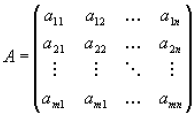 or
in a more compact form:
or
in a more compact form:
Matrix Addition and Subtraction
DEFINITION: Two matrices A and B can be added or subtracted if and
only if their
dimensions are the same (i.e. both matrices have the identical amount of rows
and columns.
Take:

Addition
If A and B above are matrices of the same type then the sum is found by adding
the
corresponding elements

Here is an example of adding A and B together

Subtraction
If A and B are matrices of the same type then the subtraction is found by
subtracting the
corresponding elements

Here is an example of subtracting matrices

Now, try adding and subtracting your own matrices

Matrix Multiplication
DEFINITION: When the number of columns of the first matrix is the same
as the number of
rows in the second matrix then matrix multiplication can be performed.
Here is an example of matrix multiplication for two 2x2 matrices

Here is an example of matrices multiplication for a 3x3 matrix

Now lets look at the nxn matrix case, Where A has dimensions mxn, B has
dimensions nxp.
Then the product of A and B is the matrix C, which has dimensions mxp. The ijth
element of
matrix C is found by multiplying the entries of the ith
row of A with the
corresponding entries
in the jth
column of B and summing the n terms. The elements of C are:
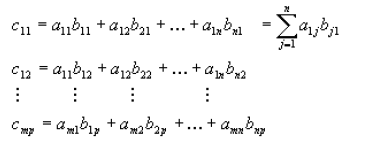
Note: That AxB is not the same as BxA
Now, try multiplying your own matrices

Transpose of Matrices
DEFINITION: The transpose of a matrix is found by exchanging rows for columns
i.e.
Matrix A = (aij) and the transpose of A is:
AT=(aji) where j is the column number and i is the row number of matrix A.
For example, The transpose of a matrix would be:

In the case of a square matrix (m=n), the transpose can be used to check if a
matrix is
symmetric. For a symmetric matrix A =
AT

Now try an example

The Determinant of a Matrix
DEFINITION: Determinants play an important role in finding the inverse of
a matrix
and also in solving systems of linear equations. In the following we assume we
have a
square matrix (m=n). The determinant of a matrix A will be denoted by det(A) or
|A|.
Firstly the determinant of a 2x2 and 3x3 matrix will be introduced then the nxn
case will
be shown.
Determinant of a 2x2 matrix
Assuming A is an arbitrary 2x2 matrix A, where the elements are given by:

then the determinant of a this matrix is as follows:

Now try an example of finding the determinant of a 2x2 matrix yourself

Determinant of a 3x3 matrix
The determinant of a 3x3 matrix is a little more tricky and is found as follows
( for this case assume
A is an arbitrary 3x3 matrix A, where the elements are given below)
then the determinant of a this matrix is as follows:

Now try an example of finding the determinant of a 3x3 matrix yourself

Determinant of a nxn matrix
For the general case, where A is an nxn matrix the determinant is given by:

Where the coefficients
 are given by the relation
are given by the relation

where
 is the determinant of the (n-1) x (n-1) matrix that is obtained by deleting row
i and
is the determinant of the (n-1) x (n-1) matrix that is obtained by deleting row
i and
column j. This coefficient
 is also called the cofactor of aij.
is also called the cofactor of aij.
The Inverse of a Matrix
DEFINITION: Assuming we have a square matrix A, which is non-singular (
i.e. det(A)
does not equal zero ), then there exists an nxn matrix A-1 which is called the
inverse of A,
such that this property holds :
AA-1= A-1A = I where I is the identity matrix.
The inverse of a 2x2 matrix
Take for example a arbitury 2x2 Matrix A whose determinant (ad-bc) is not equal
to zero

where a,b,c, d are numbers , The inverse is:

Now try finding the inverse of your own 2x2 matrices:

The inverse of a nxn matrix
The inverse of a general nxn matrix A can be found by using the following
equation:

Where the adj(A) denotes the adjoint (or adjugate) of a matrix. It can be
calculated by the following
method
•Given the nxn matrix A, define

to be the matrix whose coefficients are found by taking the determinant of the
(n-1) x (n-1)
matrix obtained by deleting the ith row and jth column of A. The terms of B
(i.e. B = bij) are
known as the cofactors of A.
•And define the matrix C, where

•The transpose of C (i.e CT) is called the adjoint of matrix A.
Lastly to find the inverse of A divide the matrix CT by the
determinant of A to give its inverse.
Now test this method with finding the inverse of your own 3x3 matrices

Solving Systems of Equations using Matrices
DEFINITION: A system of linear equations is a set of equations with n
equations and n
unknowns, is of the form of
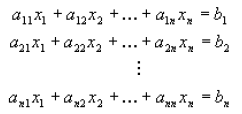
The unknowns are denoted by x1,x2,...xn and
the coefficients (a's and b's above) are
assumed to be given. In matrix form the system of equations above can be written
as:
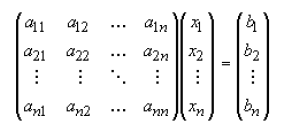
A simplified way of writing above is like this ; Ax = b
Now, try putting your own equations into matrix form by clicking here:

After looking at this we will now look at two methods used to solve matrices
these are
•Inverse Matrix Method
•Cramer's Rule
Inverse Matrix Method
DEFINITION: The inverse matrix method uses the inverse of a matrix to
help solve a
system of equations, such like the above Ax = b. By
pre-multiplying both sides of this
equation by A-1 gives:

or alternatively this gives

So by calculating the inverse of the matrix and multiplying this by the
vector b we can
find the solution to the system of equations directly. And from earlier we found
that the
inverse is given by

From the above it is clear that the existence of a solution depends on the
value of the
determinant of A. There are three cases:
1. If the det(A) does not equal zero then solutions exist using

2. If the det(A) is zero and b=0 then the solution will be not be unique or does
not
exist.
3. If the det(A) is zero and b=0 then the solution can be x = 0 but as in 2. is
not unique
or does not exist.
Looking at two equations we might have that

Written in matrix form would look like

and by rearranging we would get that the solution would look like

Now try solving your own two equations with two unknowns

Similarly for three simultaneous equations we would have:

Written in matrix form would look like

and by rearranging we would get that the solution would look like
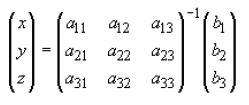
Now try solving your own three equations with three unknowns

Cramer's Rule
DEFINITION: Cramer's rules uses a method of determinants to solve systems
of
equations. Starting with equation below,
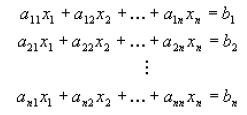
The first term x 1 above can be found by replacing the first column of A by
 .
Doing this we obtain:
.
Doing this we obtain:
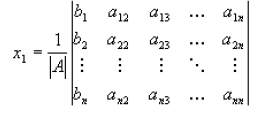
Similarly for the general case for solving xr we replace the rth
column of A by
 and expand the determinant
and expand the determinant
This method of using determinants can be applied to solve
systems of linear equations .
We will illustrate this for solving two simultaneous equations in x and y and
three
equations with 3 unknowns x, y and z.
Two simultaneous equations in x and y

To solve use the following:
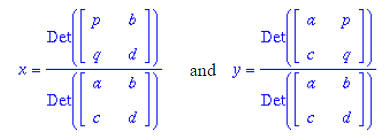
or simplified:

Now try solving two of your own equations

Three simultaneous equations in x, y and z
ax+by+cz = p
dx+ey+fz = q
gx+hy+iz = r
To solve use the following:

Now try solving your own three equations




